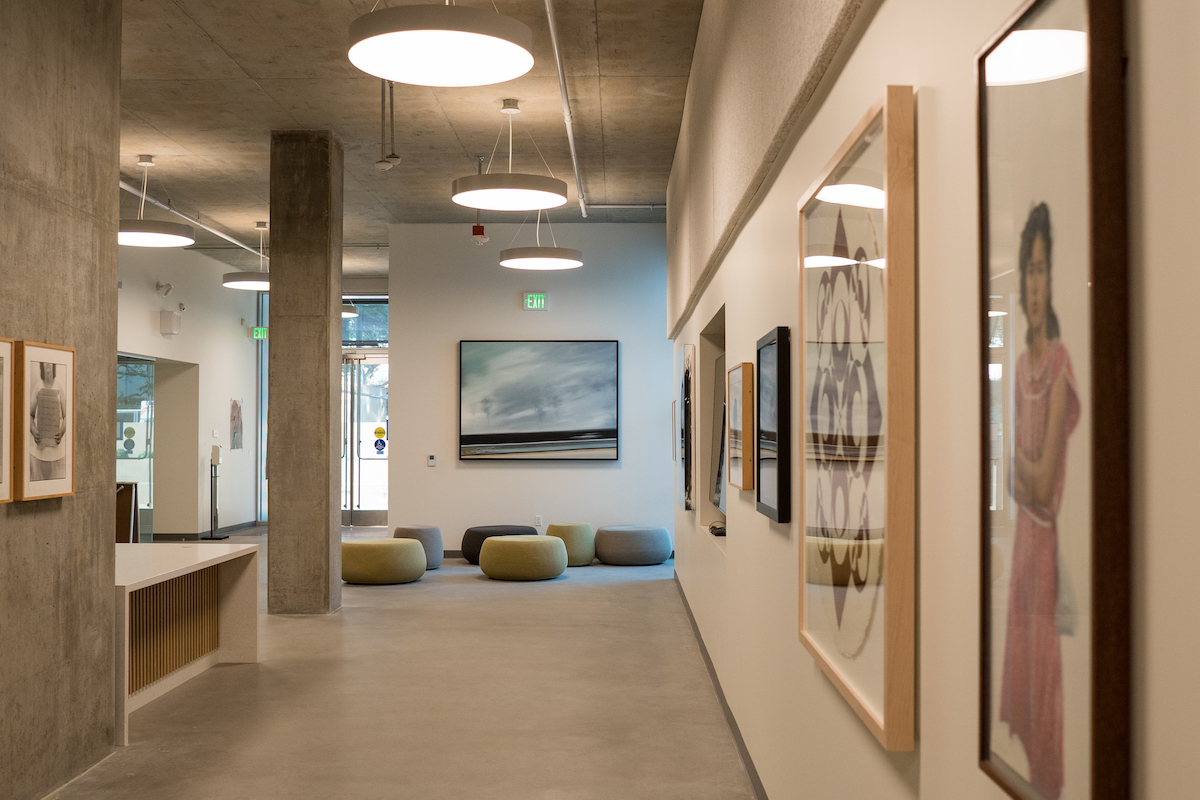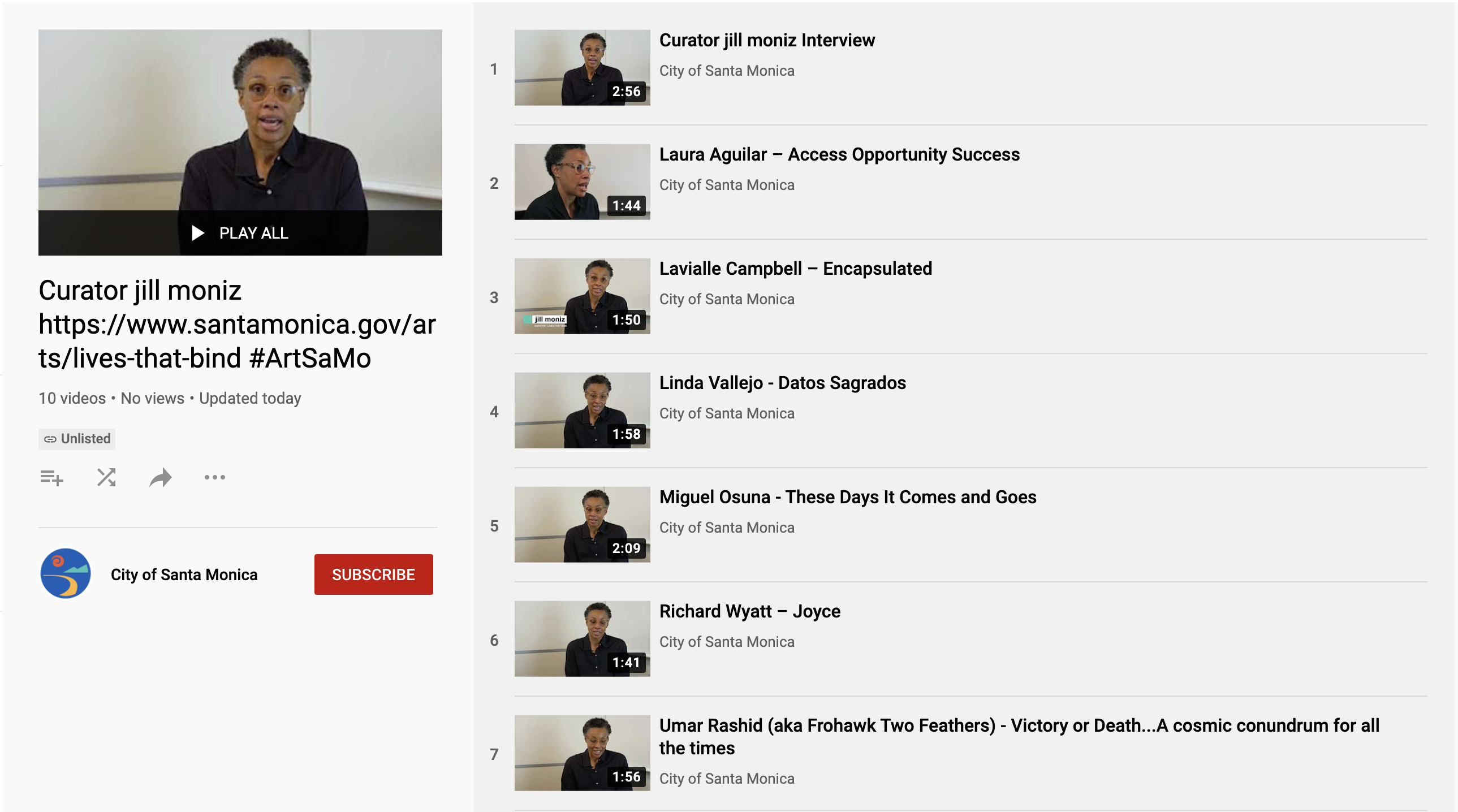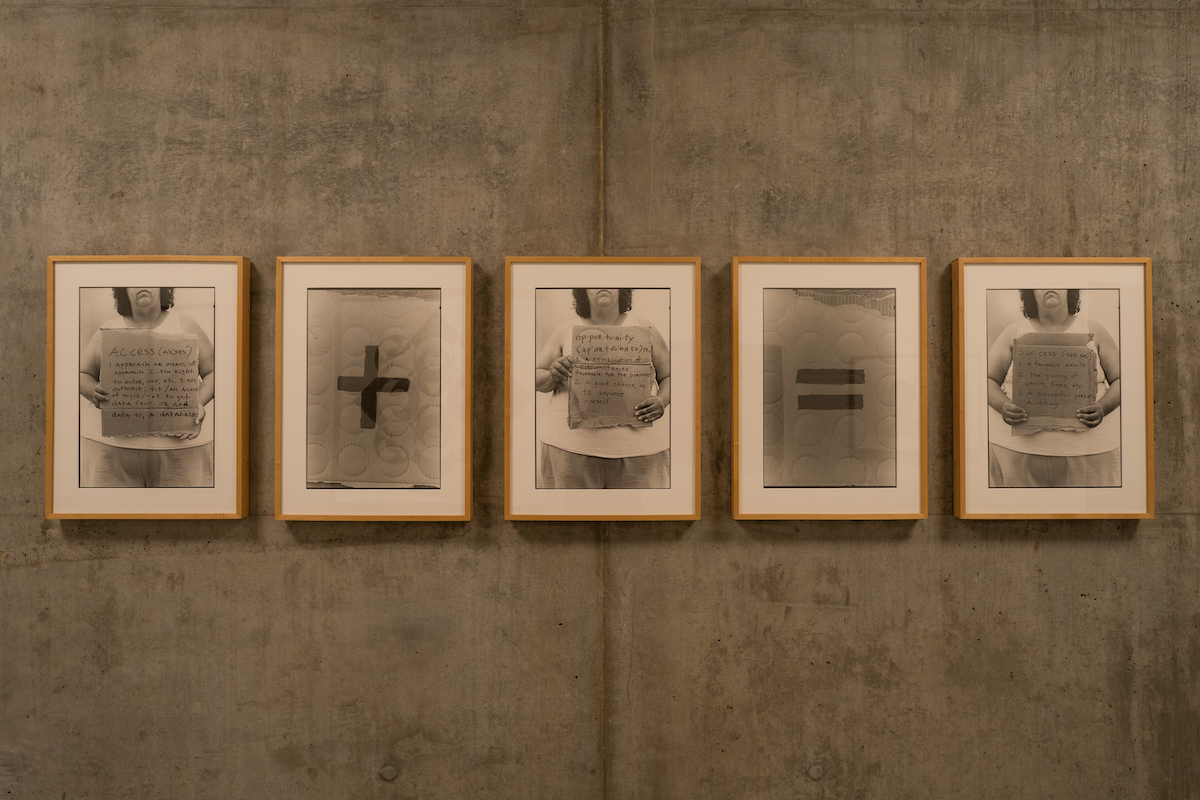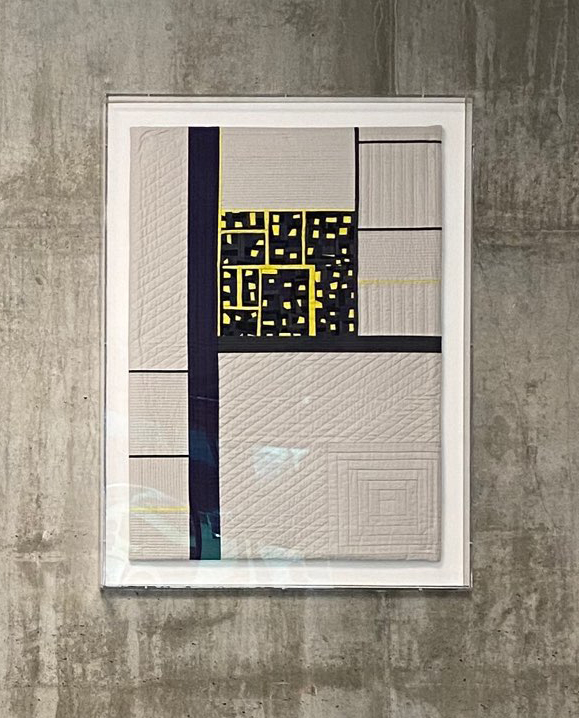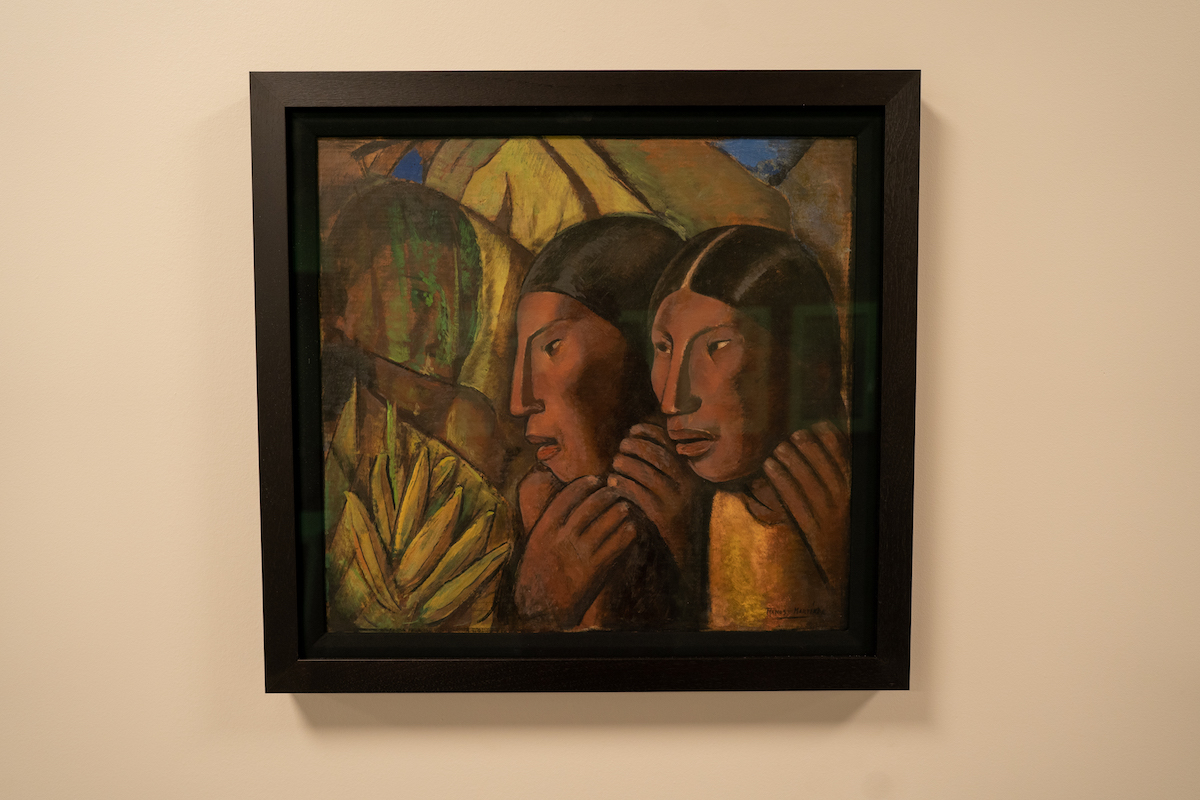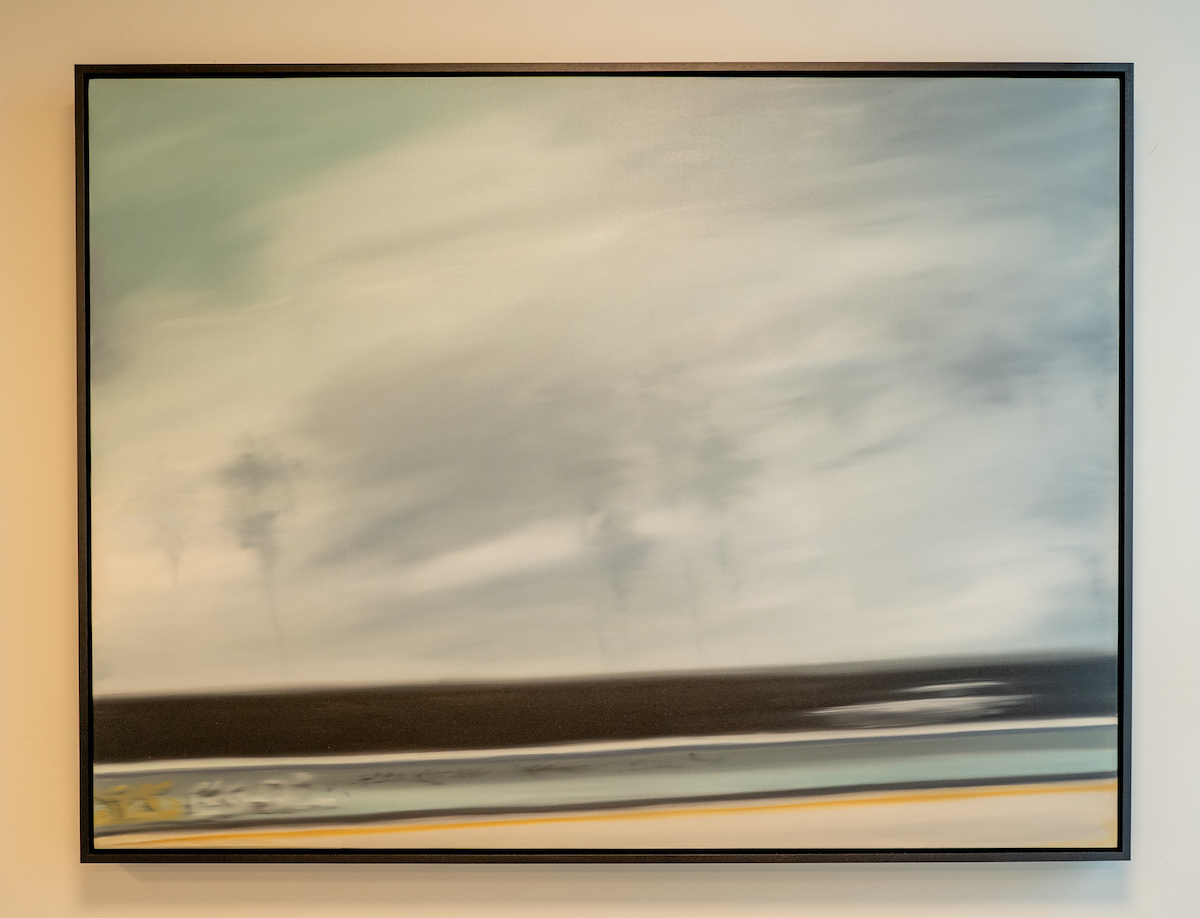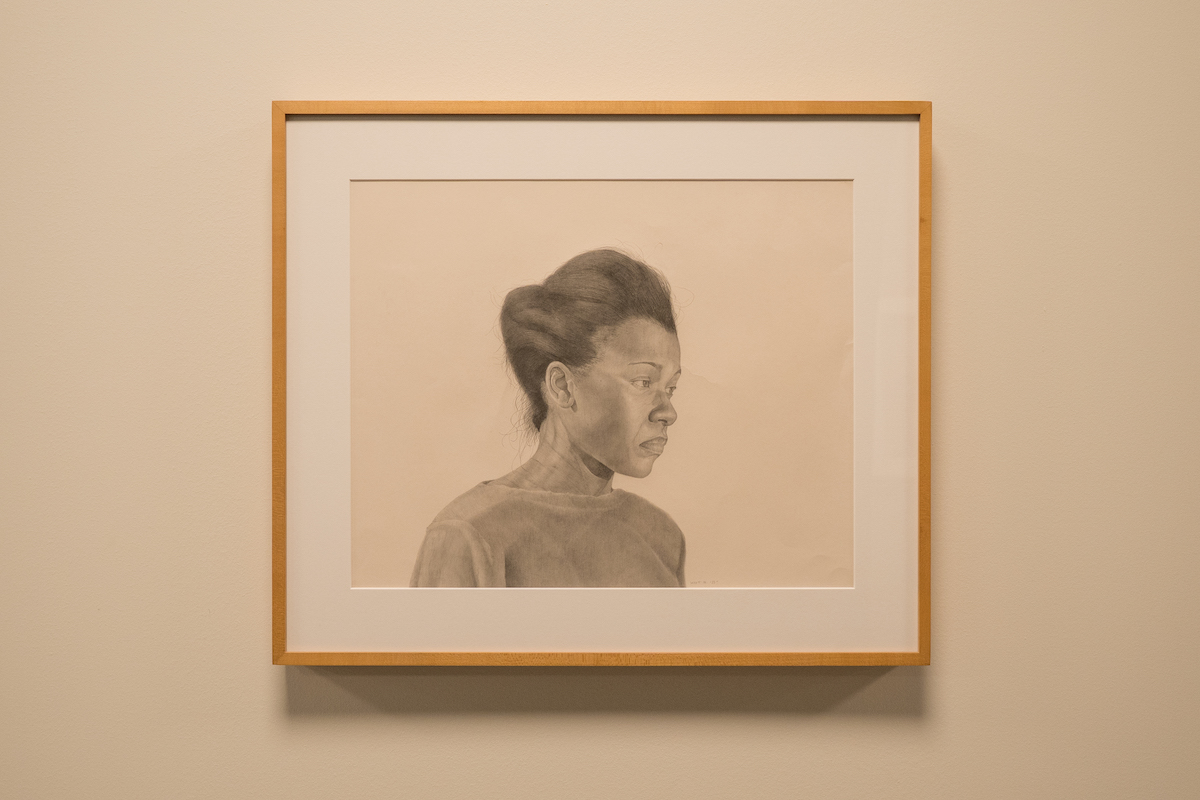Installation View, Lives that Bind, photo by Halline Overby 2020
Curator Statement:
As Santa Monica prepares for the future, we reflect on its past. Legacies of inequality—embodied in structures of representation and opportunity—demand the inclusion of previously underrepresented or erased voices and communities that are part of the City’s past, present and future. These works represent the many voices that contribute to Santa Monica’s cultural landscape, and they help visualize the importance of its diverse communities. Pieces by Lavialle Campbell, Miguel Osuna, Umar Rashid, Emma Robbins and Linda Vallejo join those by Laura Aguilar, Charles Gaines, Kerry James Marshall, Alfredo Ramirez, Alison Saar, John Valadez and Richard Wyatt, contributing to a historic and aesthetic articulation of “Lives that Bind.”
Each artist addresses erasure and underrepresentation in a unique way, and each signifies identity and place in their artmaking—concepts at the core of sustainable communities and the common good. The resonance of these works shown together speak to how diversity unites us, and how multiple perspectives can perpetually renew conversations about identity, equity, and justice.
Lives that Bind is a project of the City of Santa Monica, commissioned through its Percent for Art Program and produced by Santa Monica Cultural Affairs and the Santa Monica Arts Commission.
———–
Lives that Bind: una instalación artística sobre justicia restaurativa curada por la Dra. jill moniz
Mientras Santa Mónica se prepara para el futuro, reflexionamos sobre su pasado. Los legados de desigualdad, plasmados en las estructuras de representación y en la oportunidad, exigen la inclusión de las voces y las comunidades que anteriormente estaban subrepresentadas u olvidadas, y que forman parte del pasado, el presente y el futuro de la Ciudad.
Estas obras representan las muchas voces que contribuyen al paisaje cultural de Santa Mónica, y ayudan a visualizar la importancia de sus comunidades diversas. Las piezas de Lavialle Campbell, Miguel Osuna, Umar Rashid, Emma Robbins y Linda Vallejo se unen a las de Laura Aguilar, Charles Gaines, Kerry James Marshall, Alfredo Ramírez, Alison Saar, John Valadez y Richard Wyatt, contribuyendo a una articulación histórica de “Lives that Bind” o “Vidas que Unen”.
Cada artista aborda el olvido y la subrepresentación de una forma única, y cada una de estas formas representa la identidad y el lugar en su creación artística: los conceptos en el centro de las comunidades sostenibles y el bienestar común. La relevancia de estas obras que se muestran juntas habla sobre la forma en que la diversidad nos une y sobre cómo las múltiples perspectivas pueden renovar las conversaciones sobre identidad, equidad y justicia.
Lives that Bind es un proyecto encargado por la Ciudad de Santa Mónica a través de su Programa Percent for Art, y producido por Asuntos Culturales de Santa Mónica y la Comisión de Artes de Santa Mónica.
jill moniz’s interests focus on building understanding, creativity and inclusivity through the arts. She worked in community engagement at the Museum of Latin American Art before becoming head curator at the California African American Museum in 2006. moniz with Dr. Carlos Silveira founded Transformative Arts, a nonprofit with a mission to build citizenship and place through the arts. She served as curator to Dr. Leon O Banks, a founding trustee of MOCA before returning in 2013 to large-scale exhibitions in museums and galleries around the world. In 2016, she co-founded Quotidian, a curatorial investigative space supporting local artists and building visual literacy. Dr. moniz serves as an independent curator and an advisor on community engagement and programming to museums and galleries, and sits on advisory boards throughout the state. Before moving to California, moniz conceptualized a contemporary art museum for the Efroymson Foundation and taught social theory and discursive practice at Rosemont and Cabrini Colleges on Philadelphia’s Main Line. She holds a doctorate in cultural anthropology from Indiana University and lives in Los Angeles.
Exhibition Details
Santa Monica City Services Building, City Hall East
*City Hall East is open 7:30am to 5pm Monday through Thursday and every other Friday.
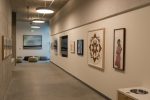 Installation View, Lives that Bind, photo by Halline Overby 2020
Installation View, Lives that Bind, photo by Halline Overby 2020
 Access + Opportunity = Success, Laura Aguilar, 1993, photo by Halline Overby 2020
Access + Opportunity = Success, Laura Aguilar, 1993, photo by Halline Overby 2020
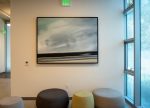 These Days it Comes and Goes, Miguel Osuna, 2013, Lives that Bind, photo by Halline Overby 2020
These Days it Comes and Goes, Miguel Osuna, 2013, Lives that Bind, photo by Halline Overby 2020
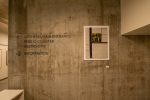 Encapsulated, Lavialle Campbell, 2017, Lives that Bind, photo by Halline Overby 2020
Encapsulated, Lavialle Campbell, 2017, Lives that Bind, photo by Halline Overby 2020
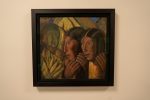 Three Women, Alfredo Ramos-Martinez c.1930, photo by Halline Overby 2020
Three Women, Alfredo Ramos-Martinez c.1930, photo by Halline Overby 2020
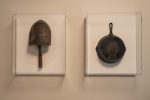
Spade Study “Red”, Alison Saar, 2001, photo by Halline Overby 2020

Faces: Men & Women, Set 5, “Constance Romero”, Charles Gaines, 1978, photo by Halline Overby 2020
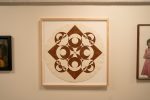 Datos Sagrados: 43.3% of US Farming Forestry & Fishery Workers are Latino, Linda Vallejo, 2017, photo by Halline Overby 2020
Datos Sagrados: 43.3% of US Farming Forestry & Fishery Workers are Latino, Linda Vallejo, 2017, photo by Halline Overby 2020
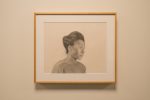 Joyce, Richard Wyatt Jr., 1985, photo by Halline Overby 2020
Joyce, Richard Wyatt Jr., 1985, photo by Halline Overby 2020
Artworks
Laura Aguilar
Access + Opportunity = Success, 1993
Gelatin silverprint photograph in 5 parts
18 in x 24 in each
About the artist
Laura Aguilar (1959–2018) was a photo-based artist who focused her work on the body as a metaphor for identity, sexuality and gender. She challenged concepts of beauty, specifically in Latina, lesbian, Black communities and through the lenses of disability and obesity. Born and raised in East Los Angeles, Aguilar was the daughter of an immigrant Mexican father and a Mexican American mother. She was hyperaware of the language of cultural and political identity, and used her position within the aforementioned alternative communities to collaborate with her subjects to disrupt photography’s authoritative gaze to create a new form of engagement centered in humanity.
Artwork Description
This was a part of Laura Aguilar’s “Will Work for” series. The formal title is for this work is “Access + Opportunity = Success.” She quite often changed titles to work throughout her career.
This work is both whimsical and deadly serious. Aguilar uses cardboard and marker to contemplate the nature of success, referencing simple ideas – opportunity and access – that are often withheld from Brown, Black and othered people. She holds the signs in a way that people often stand on the street looking for work, food or help, challenging the viewer to connect the realities of seeing people in need with future opportunities for successful outcomes and communities.
Lavialle Campbell
Encapsulated, 2017
Quilted cotton
26.75 in x 37.5 in
About the artist
Lavialle Campbell is a Los Angeles County resident, born and raised. She approaches geometric abstraction through the use of quilted thread and cotton, rejecting western-based art-making materials, and aligning herself with processes historically associated with women’s work. Most recently Campbell was featured in Walter Maciel Gallery exhibition “Pretty Big Things”. She collaborated with Lava Thomas on a major installation. Local historian Paul Von Plum wrote about their relationship in the book “Parallel Origins: The Artistic Visions of Lavialle Campbell and Lava Thomas.”
Artwork Description
This work addresses her personal journey as a black woman enduring a life time of illness and discovering a resilience and a language of survival through form. This language becomes allegorical for her community and women of color who endure to thrive.
Charles Gaines
Faces: Men & Women, Set 5, “Constance Romero”, 1978
Photographs
19 in x 23 in x 1 in each
About the artist
Charles Gaines is a conceptual artist who is interested in systems and how he can reconsider representation, movement and meaning in his art making. His profound practice considers the relationship between ideas, histories and visual language. As a professor of art at Cal Arts, he encourages his students (many of whom have become important artists themselves) to weigh material, aesthetics and the places where cultural understanding gains traction, is validated or contested. Gaines is one the most significant artistic thinkers of our time.
Artwork Description
Gaines’ portrait series “Faces” converts photographs into numbered grids that remove many of the features used to determine identity, shifting them into mapping systems that challenge the viewer’s responses to those features.
Kerry James Marshall
Are You Washed?, 1983
Acrylic paint on paper
84 in x 60 in
About the artist
Kerry James Marshall attended Otis College of Art and Design, where he was taught by Charles White and Betye Saar, artists who helped shape his understanding of the black figure. Marshall considers himself a multimedia artist whose use of diverse materials is emblematic of the complexity of Black identity, thought and representation. He focuses on concepts of beauty and desire that he can remember, imagine and project onto the figure to create a lasting imprint and conversation about the boundaries of inclusion and knowledge. He is interested in telling stories about Black life, often focusing on the inherent power and strength of Black women. He also challenges the Western gaze by subtly and directly referencing European master works in his paintings, giving the same reverence to his Black subjects that the art historical canon demands from its viewership. Marshall’s work documents the ordinary and extraordinary lives of Black people through their migration, community and aesthetics. He was the first living Black artist to have a major exhibition at the National Gallery in Washington DC and is one of the most recognized contemporary artists in the world.
Artwork Description
In this early work, Marshall hides the figure in a downpour of water. The bather, an often-considered subject of European canonical art history, is both referenced and redacted in this rendering that nods to biblical quotation while asking the viewer to imagine whose body, identity and narrative lies inside the waterfall.
Alfredo Ramos Martinez
Three Women, circa 1930
Oil paint on panel
28 1/2 in x 31 in
About the artist
Alfredo Ramos-Martínez (1871 – 1946) is known as the Father of Mexican Modernism. He studied in Mexico City and Paris, where he gained recognition for his style and subject matter. When he returned to Mexico, he established several important Open Air Schools that focused on plein air painting. David Alfaro Siqueiros was one is his many students who became globally influential. In 1929, Ramos-Martínez moved his family to Los Angele and continued to paint the lives of ordinary Mexican people. He exhibited widely, including an exhibition at the Los Angeles County Museum, and is included in important collections throughout California and beyond. He was commissioned by Scripps College in Claremont to paint a fresco which remains one of his most important and enduring works.
Artwork Description
This painting of three women embodies Ramos-Martínez’s typical stylized depiction of subjects who exhibit both grace and stoicism.
Miguel Osuna
These Days it Comes and Goes, 2013
Oil paint on canvas
54 in x 72 in
About the artist
Miguel Osuna has been painting and drawing from an early age. He studied architecture in Mexico, and a year after graduating, moved to Los Angeles. He practiced architectural design in diverse industries through 2001. In 2002 he started painting full time while visiting Buenos Aires. Upon return, he engaged in an exploration of Los Angeles, his adopted hometown, through an extensive series of abstract landscape paintings that still continues. His studio practice frequently involves investigations on different techniques, applications and materials. He presented a new body of abstract work, ‘SPIN’, in Los Angeles in November of 2012. He was invited by the California Department of Transportation to present a solo exhibition at the CALTRANS District 7 Headquarters on November 2013. Works from his series “The Bends” were included in the 2015 Ping Pong Exhibition in Basel, Switzerland during 2015 Art Basel Art Fair in June, and in Miami Beach when Ping Pong “bounces” in Miami Beach during Art Basel Miami, December 2015. His work was included in the exhibition “Work Over School” at the Craft Contemporary Art Museum of Los Angeles in September 2016. His work was included in the exhibition “Ambiguous Reality”, showing in Naples, Italy in December 2017, where he was subsequently invited to a three month art residency, by the Art 1307 Institution, culminating in a solo exhibition in May of 2018. His work is now on permanent collection and display at Pio Monte della Misericordia Museum in Naples, Italy. Osuna lives and works in Los Angeles.
Artwork Description
These Days was painted towards the end of a lengthy series of oils I did that started in the early 2000’s. The piece is emblematic of the series. Landscapes that intend not necessarily to be a portrait of a place, but rather an impression of a moment in that place. I, as many, arrived in Los Angeles from somewhere else, in search of a dream, of a better life, of an opportunity. Los Angeles provided that. Open vistas, endless horizons, and a transportation infrastructure both foreign and familiar. Moving fast, often in a motor vehicle, through neighborhoods, cities, that left fleeting and dreamy impressions in my mind. These works intend to be casual snapshots of moments and situations that can only occur in a place like this city. Do they depict actual locales? Or are they memories of something that was observed with the corner of the eye in a fraction of a second? It is up to the viewer to assign place, personal meaning, emotional response. The palette and treatments are quasi-photographic, painterly strokes are ‘erased’, favoring smooth gradients and avoiding sharp edges, yet the spatial treatment is accurate to how we perceive space. The intention, to bypass pictorial effect and promote the sensation of a place or moment that exists -or existed-, hopefully allowing the viewer to reprise a moment that was actually lived. – Miguel Osuna, Los Angeles, July 2020
Umar Rashid (aka Frohawk Two Feathers)
Victory or Death…A cosmic conundrum for all the times, 2019
Found cedar wood table top inlaid with gypsum, black stain
30 in x 55 in
About the artist
Umar Rashid (also known as Frohawk Two Feathers) has developed a narrative practice that speculates on and reinvents the stories of people of color, who are oftentimes marginalized and omitted from the historical record. He works in a variety of media to create connections between the intricacies of race, gender, class, and power in the colonial world and today. Drawing inspiration from various iconographies from Egyptian, Native American, Persian and Spanish sources, cosmological diagrams, hip hop culture, stories of incarceration and revolutionary movements, his work bridges divides between contemporary popular culture and “official” histories. Rashid recently had a solo exhibition at the Vincent Price Museum entitled “The World You Know is a Fiction”. Recent solo exhibitions include “On errythang (On Everything)” at the Wadsworth Atheneum Museum in 2014 and “What is the color when black is burned? (The Gold War Part 1)” at the University of Arizona Museum of Art in 2018; his work has also recently appeared in group shows at the Los Angeles Municipal Art Museum, François Ghebaly Gallery, and Jeffrey Deitch in Los Angeles. He is a 2020 Hammer Museum “Made in LA” featured artist. Rashid was born in 1976 in Chicago. He earned a BA at Southern Illinois University in 2000.
Artwork Description
In “Victory or Death…” he conjoins black identity politics with Mexican folkloric traditions to create a new aesthetic that describes a broader sociocultural narrative.
“In 2003, after relocating from Chicago, Il to Los Angeles, CA. I began to write and illustrate the history of the Frenglish (a portmanteau of France and England) Empire 1648- 1880 based on the supposition that the historically antagonistic empires of France and England made a tenuous peace and unified into a single, gargantuan, colonial empire. The Frenglish Empire ruled over a large swath of the planet, often challenged by the historical, traditional empires of Spain, Portugal, Netherlands, Prussia, Austria (and client states of the Holy Roman Empire), Russia, and the Ottomans. However, the main focus of my work is the stories and reinvented histories of people of color, who are oftentimes marginalized and omitted from the historical record, and the intricacies of race, gender, class, and overall power in the colonial world. In the process of writing and illustrating this history, I’ve created alternative narratives that reference the main narrative and focuses on the cosmologies of the empires, with a focus on religion and spirituality. And the common thread throughout the work (aside from the written narrative) employs iconography as a place marker between past, present, and future. This element is realized in the oeuvre in the “Imperial Tattoo System” ( a classifying mechanism I use to define and differentiate the characters in the story) and within the maps, and cosmological diagrams. The narrative is also massively informed by the hip hop culture of my youth (golden age), various (modern and ancient) pop culture references, gang and prison culture, and revolutionary movements throughout time.”
-Umar Rashid
Emma Robbins
Blue Bird Flour Rug III, 2016
Blue Bird Flour bags, acrylic hair
45 in x 46 in
About the artist
Emma Robbins (Diné, b. 1986) lives and works in Los Angeles and on the Navajo Nation. She completed her BFA at the School of the Art Institute of Chicago and studied Contemporary and Modern Latin American Art in Argentina. She is the Director of the Navajo Water Project, providing access to clean, running water to communities on the Navajo Nation. Robbins has been featured on NPR, VICE, Nylon Magazine, BBC, and Democracy Now!, and has lectured at the Massachusetts Institute of Technology, the School of the Art Institute of Chicago, the Global Climate Action Summit and the Indigenous Peoples Movement March for her art, activism and humanitarian work. She has exhibited both in the US and internationally.
Artwork Description
Blue Bird Flour Rug III, is a combination of Blue Bird Flour bags, a package made of cotton fabric for baking flour used by many Diné on the Navajo Nation, and black, synthetic hair merged together. Together these two materials, both of which Robbins has worked with obsessively over the years, form a rug based off of a traditional Diné design. Like all of Robbins’ work, this is a combination of real, manipulated objects from the reservation and items of the “Indian” archetype, forcing the viewer to question the authenticity of what it is that they are witnessing.
Alison Saar
Skillet Study “Elizha”, 2001
Found iron skillet with acrylic paint
20 1/4 in x 23 1/4 in x 5 1/2 in
About the artist
Alison Saar is one of America’s premiere sculptors and a leader of the contemporary black arts movement in Los Angeles. As the daughter of assemblage artist Betye Saar and ceramist Richard Saar who grew up in LA during one of the most politically and socially active historical moments of the century, Saar has developed a visual language of mysticism and nature that investigates the human potential for empirical evidence and knowledge. She earned a BFA from Scripps College and an MFA from Otis College of Art and Design, learning form from many of the region’s sculptural giants. Saar has found a unique space for herself, working with a chainsaw on rough-hewn figures and incorporating found objects that are metaphors of women’s work, Black labor and larger communal narratives. Her work emphasizes that the Black body matters in aesthetic discourse, with objects that substantiate connections to spiritual architecture, cultural memory and visionary Black aesthetics.
Artwork description
In this work, Saar merges function and identity to remind the viewer that Blacks built this country not simply as mechanisms of slavery, but as individuals with names and histories greater than their forced labor.
Alison Saar
Spade Study “Red”, 2001
Found steel shovel with acrylic paint
20 1/4 in x 23 1/4 in x 5 1/2 in
About the artist
Alison Saar is one of America’s premiere sculptors and a leader of the contemporary black arts movement in Los Angeles. As the daughter of assemblage artist Betye Saar and ceramist Richard Saar who grew up in LA during one of the most politically and socially active historical moments of the century, Saar has developed a visual language of mysticism and nature that investigates the human potential for empirical evidence and knowledge. She earned a BFA from Scripps College and an MFA from Otis College of Art and Design, learning form from many of the region’s sculptural giants. Saar has found a unique space for herself, working with a chainsaw on rough-hewn figures and incorporating found objects that are metaphors of women’s work, Black labor and larger communal narratives. Her work emphasizes that the Black body matters in aesthetic discourse, with objects that substantiate connections to spiritual architecture, cultural memory and visionary Black aesthetics.
Artwork description
In this work, Saar merges function and identity to remind the viewer that Blacks built this country not simply as mechanisms of slavery, but as individuals with names and histories greater than their forced labor.
John Valadez
Flora, 1986
Pastel on paper
38 in x 15 in
About the artist
John Valadez is one of the most recognized artists from the Los Angeles area Chicano Movement. He began is arts education in East LA, then graduated from Cal State Long Beach. He was politically active as street artist who documented the shifting visual language of the moment. Valadez photographs street scenes then renders the imaginary as a painting, often isolating and centralizing the figure which gives agency to the subject. These photorealist paintings interpret the radical stories that shape life in Los Angeles.
Artwork Description
In this work, like many of Valadez’s paintings, the subject stares at the viewer, reminding us of the photographic origins of the work. Her direct gaze suggests the question of agency; who determines what is recorded. Valadez removes the background and context of the image, so that the viewer has an intimate and potentially challenging encounter with the subject.
Linda Vallejo
Datos Sagrados: 43.3% of US Farming Forestry & Fishery Workers are Latino, 2017
Gouache and pencil on handmade paper
44 in diameter
About the artist
Linda Vallejo consolidates multiple, international influences gained from a life of study and travel throughout Europe, the United States and Mexico to create works that investigate contemporary cultural and socio-political issues.
Solo exhibitions of her work Make ‘Em All Mexican, The Brown Dot Project, and Datos Sagrados have been presented at LA Plaza de Cultura y Artes (2019-2020); Kean University, Karl & Helen Burger Gallery, Union, New Jersey and Museum of Latin American Art, Long Beach, CA (2018); bG Gallery, Santa Monica (2017); Texas A&M University Reynolds Gallery (2016); Bert Green Fine Art, Chicago Ill, Salt Fine Art, Laguna Beach CA, UCLA Chicano Studies Research Center, Los Angeles CA (2015); Lancaster Museum of Art and History in Lancaster CA (2017 & 2014) and the Soto Clemente Velez Cultural Center in New York (2014), George Lawson Gallery in Los Angeles and the University Art Gallery of New Mexico State University (2013), as well as Arte Americas in collaboration with the Fresno Art Museum and Central California Museum of Art Advisory Committee and California State University, San Bernardino, Fullerton Museum (2012).
The Brown Belongings solo exhibition featuring 125 works and a 140-page catalog was featured in the NY Times “Visualizing Latino Populations Through Art” by Jill Cowan, New York, NY (November 26, 2019) and in LA Times “Linda Vallejo and a decade of art that unapologetically embraces brownness” by Matt Stromberg (June 20, 2019).
Her work is in the permanent collections of the Museum of Sonoma County, Santa Rosa, CA, Museo del Barrio, New York, NY, East Los Angeles College Vincent Price Museum, Los Angeles CA, National Museum of Mexican Art, Chicago Ill, Carnegie Art Museum, Natural History Museum of Los Angeles County, CA, UC Santa Barbara, California Ethnic and Multicultural Archives (CEMA), Santa Barbara, CA, UCLA Chicano Study Research Center (CSRC), Los Angeles, CA, California Digital Library, Arizona State University Library Archives.
Artwork Description
Datos Sagrados are “data pictographs” where the number of painted spaces represent actual data. These data-based works reflect various types of data, including the Latino proportion of city and state populations, of professionals in the health, education, and other sectors, and of the US gross national product.
This piece represents the fact that “43.3% of US Farming Forestry & Fishery Workers were Latino in 2015,” as reported by the US Board of Labor Statistics. Here is how the math is calculated. This piece contains 130 drawn spaces in which 56 are painted brown. 130 x 43% = 56. The number of brown painted spaces correlates directly to the data.
Richard Wyatt Jr.
Joyce, 1985
Pencil on paper
25 in x 21 1/4 in x 1 3/4 in
About the artist
Richard Wyatt Jr. is a Los Angeles-based painter best known for his large scale murals. He attended Otis Art Institute’s Tutor Art program where he studied with Charles White, John T. Riddle Jr. and William Pajaud. He then earned a Bachelor of Fine Art from UCLA. Wyatt’s subject matter often depicts stories of migration, the importance of memory, and the creativity that is foundational to Black tenacity and ongoing survival. His work has been included in many important exhibitions about art in LA and his murals can be seen at Union Station in Downtown LA, as well as the Capitol Records Building and the Watts Towers Art Center.
Artwork Description
Wyatt often creates portraits of people he knows and admires. These intimate works are highly detailed and give the viewer a greater understanding of Wyatt’s relationship to the subject as he delicately rendering all of what he sees.

